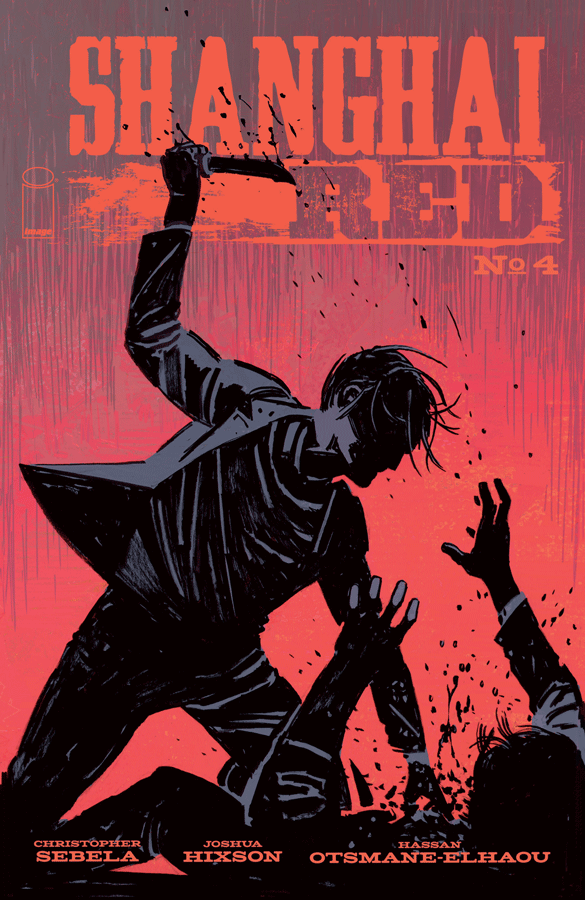THIS REVIEW OF ‘SHANGHAI RED’ #4 IS SPOILER-FREE.

Cover to ‘Shanghai Red’ #1. Art by Joshua Hixson/Image Comics
by Clyde Hall. People who’ve endured employment in a modern, toxic work environment probably feel Shanghai Red more than most. The small bitter tang in the back of our throats akin to the suffocating nettles poisoning Red during her entire hellish two years of crimped service aboard the good ship Bellwood. Likely, amidst the fresh meat cluelessly brought aboard both that vessel of sorrows and the toxic cubicle hutch, they were treated as something fecal stuck on a shoe—belittled, marginalized, given every low duty that management could devise.
All the while the inference would be how fortunate they were to serve, as literal slaves or wage slaves, at the sufferance of a far too lenient supervisor. If you managed to survive while a huge percentage of your fellow neophytes quit, made career-ending comments, or were simply deemed unnecessary, chances are you got the same ‘opportunity’ eventually that Red did. One of your tormentors breezed in and generously offered a place beside them, a regular position, complete with laughably insignificant wage increases and wolfish guffaws over how your tormentor had fostered you into a worthy candidate with their heap of past mistreatment. Now you could join him or her and make the incoming batch of newbies just as miserable as you’ve been, and the natural cycle will be complete. There was really no question in the tiny, sadistic mind of your benefactor that you’d jump at the chance to abandon the trenches to take position on the gauntlet of woe each lowly must run. The only surprise might be if you turned down their offer, slapped the proposition-bearer unconscious, and quit. Which was Red’s reaction initially, though with a more 19th Century Two Years Before the Mast level of lethal intensity when the series began.
Red’s experience, of course, is vested in maritime law and practice of the late 1800s as well as illegality within that context, so her toxic environment included death, torturous living conditions, and floggings. Or worse. But her response, and the driving force behind Shanghai Red as we come to issue #4, is that she’d rather die than become anything like her captors. In previous issues, she instead took over the Bellwood, proved herself a capable leader, and set upon the dual road of reckoning and recovery while avowing to prevent the men responsible for her crimping to ever press another innocent into service. The reckoning portion has taken her back to Portland, the site of her abduction, tracing the footsteps of her captors and their bosses, making good her oath to end their practice. To end them.
Red’s ongoing recovery from her tribulation is committed to a journal, with excerpts triggering mirrored scenes between past experiences and the situations of her present. It’s a shrewd approach writer Christopher Sebela employs, and he manages it with empathy-establishing mastery. In previous issues, artist/colorist Joshua Hixson’s understated approach to these sudden time shifts may have slowed the flow for some readers. Is this now, or was it then? By issue #4, readers should be acclimated to Hixson’s segues and be appreciative that his style reflects exactly the tangle of traumatic emotions haunting our hero. Letterer Hassan Otsmane-Elhaou boldly adds to those pivots with script for the journal captions, and his onomatopoeia virtually provide a needed source of light for panels otherwise confined to the labyrinthian underdark.
Sebela continues the exploration of Portland’s dark past, in this case the Shanghai Tunnels running beneath the early city. Possibly apocryphal tales of the underground’s use for crimping and illegal trade are spice to his narrative’s stew of violence, revenge, and criminality. And while Red makes progress on her quests for payback and for conciliation with family and with herself, it doesn’t come without a price, as well as a few lessons regarding deception. She may have survived two years of a living hell, but the tormentors in Portland introduce her to new, twisted cul-de-sacs. The wild and winding backways lead to a showdown that will add to raucous legends of criminal warfare along the 1890s waterfront.
DoomRocket luminary Brendan F. Hodgdon’s Imagery feature back in June set my path to follow Shanghai Red, and Sebela’s work on Crowded (Image Comics) and House Amok (IDW/Black Crown) in the meantime has placed him on a short list of my favorite writers this year. His range between those two titles alone validates his white-hot summer of hits.
In a period when companies tout the sensational death of an established character to move product, Shanghai Red #4 ends with this reader still uncertain whose corpses may lie shrouded beneath the last act curtain when it falls. It’s simply part of a journey, one where life is cheap and life is tenuous, survival based on the whim of a cruel era and place. No matter the collateral damage, no matter the price or the sacrifice, expect Red and Jack to remain defiant until the bittersweet end.
Image Comics/$3.99
Written by Christopher Sebela.
Illustrated by Joshua Hixson.
Letters by Hassan Otsmane-Elhaou.
8 out of 10


















